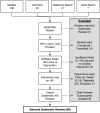A review on systematic reviews of health information system studies
- PMID: 20962125
- PMCID: PMC3000756
- DOI: 10.1136/jamia.2010.004838
A review on systematic reviews of health information system studies
Abstract
The purpose of this review is to consolidate existing evidence from published systematic reviews on health information system (HIS) evaluation studies to inform HIS practice and research. Fifty reviews published during 1994-2008 were selected for meta-level synthesis. These reviews covered five areas: medication management, preventive care, health conditions, data quality, and care process/outcome. After reconciliation for duplicates, 1276 HIS studies were arrived at as the non-overlapping corpus. On the basis of a subset of 287 controlled HIS studies, there is some evidence for improved quality of care, but in varying degrees across topic areas. For instance, 31/43 (72%) controlled HIS studies had positive results using preventive care reminders, mostly through guideline adherence such as immunization and health screening. Key factors that influence HIS success included having in-house systems, developers as users, integrated decision support and benchmark practices, and addressing such contextual issues as provider knowledge and perception, incentives, and legislation/policy.
Conflict of interest statement
Figures



References
-
- Schoen C, Osborn R, Huynh PH, et al. On the front lines of care: Primary care physician office systems, experiences and views in seven countries. Health Aff 2006;25:w555–71 - PubMed
-
- Ammenwerth E, de Keizer N. An inventory of evaluation studies of information technology in health care. Methods Inf Med 2005;44:44–56 - PubMed
-
- Han YY, Carcillo JA, Venkataraman ST, et al. Unexpected increased mortality after implementation of a commercially sold computerized physician order entry system. Pediatrics 2005;116:1506–12 - PubMed
-
- Del Becarro MA, Jeffries HE, Eisenberg MA, et al. Computerized provider order entry implementation: no association with increased mortality rates in an intensive care unit. Pediatrics 2006;119:290–5 - PubMed

